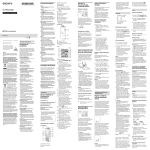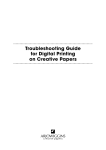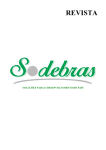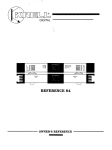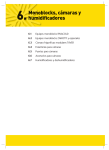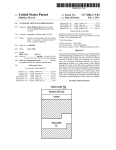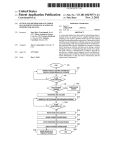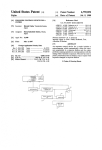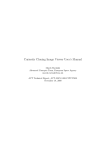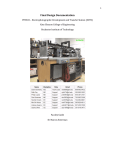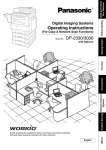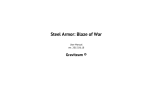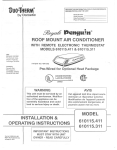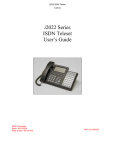Download Job recovery technique in a document copier machine
Transcript
United States Patent [191
[11]
4,421,404
Conly
[45]
Dec. 20, 1983
[54]
JOB RECOVERY TECHNIQUE IN A
4,229,100 10/1980 Travis ................................. .. 355/77
DOCUMENT COPIER MACHINE
4,229,477
11/1981
4,327,993
5/1982
v
[75]
Inventor:
Douglas J. Conly, Boulder, Colo-
[73] Assignee: International Business Machines
Corporatlon’ Armonk’ N‘ '
Ward et a1.
._._.....
. . . . . .. 355/14 R
Gauronski et a1. .
.. 355/3 SH X
4,33s,023 7/1982 McGibbon ................. .. 355/3 SHX
Primary Examiner__A. C‘ Prescott
Attorney, Agent, or Firm-C. E. Rohrer
[21] Appl. No.: 374,848
2
[
Z
Fl d
1
le
M
:
4 1982
ay
[57]
,
.....
[51]
Int. Cl.3
[52]
US. Cl. ........................... .. 355/ 14 CU; 355/ 14 R;
[ 58 1
F‘‘e 1d 0 fS ea“: h """"" " 355/14 CU ’ 14 RA; 14 SH ’
355/3 SH’ 3 R’ 5O’ 77; 271/3'1’ ’ 5* 6’ 7
. . . . . . . . . . . . . . . . . . ..
G03G 15/00
355/14 SH; 271/31
[56]
ABSTRACT
.
.
.
.
A document cop1er machlne w1th an automat1c docu
ment
feeder
(ADF)
combined
with
a
recovery procedure in which multi 1e ori inals may
need recopying in order to replace pcopiesg destroyed
when ajam occurs, The procedure calls for feeding the
References Cited
required number of originals needed for recopy through
Us. PATENT DOCUMENTS
the SAlDF and once the jam recovery is complete,
4078 787
,
,
4,192,607
3/1978 B l
l
V31
ureweta. ..................... ..27
.
3/1980 Hage ................................... .. 355/50
4,206,996
6/1980
4,212,457
7/1980 Guenther ................. .. 355/ 14 SH X
automatlc restarting of the ADF occurs 1n order to
'
h
complete the Job Interrupted byt Clam‘
Clark et al. ..................... .. 355/14 C
9 Claims, 8 Drawing Figures
2]
11
\
35g “ m
”\f
\5e
o
r_—_t———t_
o t
U
32
19
u
semiautomatic
document feeder (SADF) is operated according to a job
‘‘
"22
31A
m
24
23
an
\
34
525
42s
21
18
‘
50
° 28 36
3'1
US. Patent
FIG.'I
Dec. 20, 1983
Sheet 1 of8
4,421,404
U.S. Patent
Dec. 20, 1983
E
Sheet 2 of8
4,421,404
US. Patent
Dec. 20, 1983
Sheet 3 of8
118
E _____________________
69
i
{
i
2 4 a’ r"
//
4,421,404
US. Patent
FIG. 4
Dec. 20, 1983
Sheet 4 of8
4,421,404
US. Patent
Dec. 20, 1983 I
Sheet 5 of8
4,421,404
FIG. 5
./ 302
DECREMENT
REDDPY
COUNTER IF
NOT ALREADY ZERO
ADD
INDICATED
RECDPIES T0
RECOPY
COUNTER
ADF
ACTIVE ?
iggPEND
(ALLOW ADF
BYPASS)
A08
RESTART /305
ADF
Sheet 6 of 8
US. Patent I Dec. 20, 1983
FIG. 6A
REOOPY
OOUNTER=O ?
TIMEOUT OR
ADF EMPTY OR
JOB 2,ADF HAS
JOB 1 ORIGINAL?
SET RECOPY
COUNTER
/402
T0 ZERO
T
"RESTAOK AOF" /403
MESSAGE
l
RESET ANY
/ 404
SADF INHIBITS
DUE TO ADF
OPERATION
MANUAL JOB
IN PROGRESS OR
DOCUMENT FEEDER
INITIATEO START
REOUEST ?
OALL
DEOREMENT
PROCEDURE
OALL
INOREMENT
PROCEDURE
4,421,404
US. Patent
Dec. 20, 1983 .
Sheet7 of8
DECREMENT PROCEDURE
FIG. 6B
‘
SET JOB START JUST / 406
OCCURRED FLAG
JOB START
JUST OCCURRED?
DECREMENT
/409
RECOPY COUNTER
RECOPY COUNTER
NOW =O ?
RESET ADF
f4“
START INHIBIT
4,421,404
U.-S. Patent
Dec. 20, 1983
Sheet 8 of8
4,421,404
FIG. 6C
INCREMENT PROCEDURE
N0
>
ORIGINALS
0N GLASS ?
RESET
/ 50]
502
ANY RECOPY
MESSAGES
DISPLAYED ?
RECOVERY JOB
STARTED ?
SET
RECOPY MESSAGE A05
JUST TURNED ON
FLAG
RESET
MESSAGE JUST
TURNED 0N ?
_E
ADF
LOADED ?
ADD PROMPTED /5°8
RECOPIES T0
RECOPY COUNTER
&
/5°4
RECOPY MESSAGE
JUST TURNED ON
FLAG
/
mBgARTS 509
L_______
REQUET ADF /sn
OPERATION
w
1
4,421,404
2
nately, the transfer operation seldom transfers 100% of
the toner from the receptor to the copy paper.
Toner remaining on the photoreceptor after transfer
is called residual toner.
JOB RECOVERY TECHNIQUE IN A DOCUMENT
COPIER MACHINE
This invention relates to document copiermachines 5
matically restarting an automatic document feeder fol
lowing recovery from a paper jam.
BACKGROUND OF THE INVENTION
The remaining process steps call for permanently
bonding the transferred toner material to the ‘copy
paper and cleaning the residual toner left on the photo
receptor so that it can be reused for subsequent copy
and more particularly relates to a technique for auto
production.
10
In electrophotographic document copier machines,
In the cleaning step, it is customary to pass the photo
receptor under a preclean charge generating station to
copies of documents or other subjects are produced by
neutralize the charged areas on the photoreceptor. The
creating an image of the subject on a photoreceptive
photoreceptor may also be moved under an erase lamp
surface, developing the image and then fusing the image
to copy material. In machines which utilize plain bond
copy paper or other ordinary image receiving material
not specially coated, the electrophotographic process is
of the transfer type where a photoreceptive material is
to discharge any remaining charge. In that manner, the
residual toner is no longer held by electrostatic attrac
tion to the photoreceptive surface and thus it can be
more easily removed at a cleaning station.
In order to avoid overburdening the cleaning station,
placed around a rotating drum or arranged as a belt to
it is customary to remove all charge present on the
be driven by a system‘of rollers. In the typical transfer
process, photoreceptive material is passed under a sta
tionary charge generating station to place a relatively
uniform electrostatic charge, to a potential which is
usually several hundred volts, across the entirety of the
material between the trailing edge of one image and the
leading edge of the next. Also, erase lamps are used to
photoreceptive surface. Next, the photoreceptor is
moved to an imaging station where it receives light rays
reflected from the document to be copied. Since white
areas of the original document re?ect large amounts of
light, the photoreceptive material is discharged in white
areas to relatively low levels while the dark areas con
tinue to contain high voltage levels even after exposure.
In that manner, the photoreceptive material is caused to
bear a charge pattern which corresponds to the print
ing, shading,’ etc. present on the original document and r
is therefore, an electrostatic image of that document.
Electrophotographic machines may also be orga
nized to provide a printing function where the image on
the photoreceptive surface results from character gen
eration rather than from an optical review of an original
document. Character generation may be produced, for
example, by driving a light generating source from
information held in digital memory. The generating
photoreceptive surface outside of the image area prior
to the development step. This is usually done by using
an interimage erase lamp to discharge photoreceptive
erase charge along the edges of the photoreceptor out
side of the image area. For example, if the original docu
ment is 8.5X1l inches in size, and if a full sized repro
duction is desired, the dimensions of the image on the
photoreceptor will also be 8.5 X ll inches. The interim
age and erase lamps remove charge outside of the
8.5 X ll-inch image area.
A common variation on the above-described process
used in many electrophotographic machines involves
the use of specially prepared paper where the copy
paper itself carries a coating of photosensitive material.
By utilizing that technique, the image is electrostatically
painted directly on the copy paper. The copy paper is
sent through a developer and then to a fuser for perma
nent bonding. Machines of this type avoid the residual
toner problem and therefore there is no need for clean
ing stations, erase lamps, preclean generating coronas,
etc. However, the resulting copy paper with its special
photosensitive coating is much more expensive than
source may be .a laser gun, an array of light-emitting
plain bond copy paper and the special coating is consid
diodes, light modulators, etc. which direct light rays to 45 ered to detract from the resulting product. As a conse
the photoreceptor and cause it to bear a charge pattern
quence, coated paper machines are usually favored only
which is an image of the information used to drive the
for low volume applications or where quality product is
generating source.
not essential.
After producing an image on the photoreceptor, the
In addition to the fundamental mechanisms used for
next step in the process is to move the image to a devel
producing a copy or print, modern electrophotographic
oping station where developing material called toner is
machines have been developed with many features
placed on the image. This material may be in the form of
which are designed to ease the difficulty of using the
a black powder which carries a charge opposite in po
machines. For example, semiautomatic (SADF) and
larity to the charge pattern on the photoreceptor. Be
automatic (ADF) document feed devices, including a
cause of the attraction of the oppositely charged toner,
variety which recirculates the originals, ease the entry
it adheres to the surface of the photoreceptor in propor
of documents to be copied. Collators are often added to
tions related to the shading of the original. Thus, black
the base machine so that collated sets of copies can be
character printing should receive heavy toner deposits,
automatically produced. Many machines have a duplex
white background areas should receive none, and gray
function so that copies can be produced on both sides of
or otherwise shaded half-tone character portions of the 60 the copy sheet. Other features add to machine versatil
original should receive intermediate amounts.
ity such as the production of copies which are a reduced
The developed image is moved from the developer to
or magni?ed version of the original document. Other
features improve copy quality such as mechanisms for
ally paper, is juxtaposed to the developed image on the
controlling the concentration of toner in machines
photoreceptor. A charge is placed on the back-side of 65 which utilize a carrier/toner development mix. Many
modern electrophotographic machines are controlled
the copy paper so that when the paper is stripped from
by microprocessors rather than by hardwired analog or
the photoreceptor, the toner material is held on the
digital logic. The use of microprocessors has enabled
paper and removed from the photoreceptor. Unfortu
a transfer station where a copy receiving material, usu
4,421,404
3
4 ,
the addition of many new innovative functions atlow
cost such as, for example, error logs and automatic
diagnostic capabilities to ease troubleshooting and im
prove maintenance. Microprocessor routines have also
aided in the establishment of a degree of “arti?cial intel
ligence” to anticipate the'needs of the machine user in
document feed operations, collate, and other areas.
FIG. 2 is a diagrammatic view of the major functional
mechanisms used in an automatic/semiautomatic docu
ment feed device for use with the machine of FIG. 1.
FIG. 3 is a view of the paper path of the machine of
FIG. 1 showing two collator modules attached to the
base machine.
‘
I
I
I
\
~
FIG.v 4 is a detailed view of the paper path within‘ the
Additionally, microprocessors have made economical
?rst collator module.
the addition of innovative functions such as the provi
sion of separator sheets between different sets of copies 10
'
I
-
-
_
FIG. Sis a schematic ?owchart showing the tech
nique of the instant invention.
within a collator.
'
'
i 2
As may be appreciated from the above, the basic
electrophotographic machine involves the interaction
FIG. 6 comprised of FIGS. 6A-6C, vis a detailed
?owchart showing an implementation of the instant
invention in the environment provided by the machine
of several important subsystems to produce a copy sheet
of FIGS. 1-4.
I‘ '
\
or print and several other subsystems which control 15'
copy quality or which provide convenience functions.
In addition, modern copier machines have been devel
oped to run at high speeds so that, at any 'one time,
several copy sheets can be located along the copy paper
path from the image-receiving station to the exit station. 20
These sheets can all be copies of the same original docu-'
. ment, but in many cases these sheets will bear an image’
of more than one original. As a result, if a paper jam
occurs necessitating a machine shutdown and a clearing
of all sheets in the copy paper path, copies of several 25
different originals might be thrown away thereby caus
ing a need to recopy these same several different origi
nals in order to recover from the jam. U.S. Pat. No.
4,229,100 to Travis (IBM) discloses such a machine and
describes a system which utilizes counts for precisely
recovering from loss of copy sheets due to a jam or
other stoppage conditions. In the described system, the
maximum number of originals for which recopies might
need to be made is limited to three and the system iden
ti?es the number of originals, one, two, or three which
need to be recopied. A similar technique is used onthe
commercially available IBM Series III Copier/Duplica
tor. However, the system described by Travis, as well ‘
RELATED DOCUMENTS '
This invention is to be described in the context of the
IBM Series III Copier/Duplicator. For a complete
description of the subsystems of this copier, reference
should be made to Service Manual, P/N 1677450, or to
P/N 1674073; for a description of jam recovery proce
dures to U.S. Pat. No. 4,229,100, mentioned above;.and
U.S. Rat. No. 4,170,414 which describes the micro
processor used in the machine.
DETAILED DESCRIPTION
‘
~ FIG. 1 shows a perspective view of the IBM Series
III Copier/Duplicator. Control tower 10 contains a set
of keys or buttons 11 which may be selected by an
operator to instruct the machine to perform various
functions. For example, this set of keys contains a push
button for a ?rst reduction mode, another for a second
reduction mode, one for the duplex operation,‘ one for
collate, another for separate, for interrupt, buttons for a
light copy or dark copy mode, and others. The number
of copies to be made is selected by the operator from the
push buttons 12 with the number selected appearing in
numeric display 13. Control tower 10 also‘contains a
as commercially available machines, require the inser
start button 14 and a stop reset button 15. Messages to
tion of makeup originals by the machine user, and, after’ 40 instruct’ the operator to take corrective action appear in
jam recovery, require operator intervention to restart
the area 16.
'
i '
'
the job interrupted by the work stoppage.
FIG. 1 also shows a tray 17 for the automatic docu
SUMMARY OF THE INVENTION ,
ment feed. A stack of original sheets may be fed one at
a time automatically from this tray__to ‘the document
Brie?y stated, this invention relates to job recovery in 45 processing station. Tray 18 is provided to accept sheets
an electrophotographic copier machine with an auto
matic document feed device, wherein a number of copy
from the hand of the operator one at a time for semiau
sheets bearing images of several original documents
After processing, the original documents are exited into
tomatically feeding sheets tov the processing station.
may be present in the copy paper path at a given instant.
an area 19 and the ?nished copy sheet is exited into a
When a jam occurs in such a machine, the job recovery 50 tray 20. FIG. 1 does not show a‘ collator module with
technique of this invention calls for clearing the jam,
the machine.
_
‘
inserting all original documents to_ be recopied, prefera
FIG. 2 is a diagrammatic front view of the automatic
bly through a semiautomatic document feeder in a ma
document feed/semiautomatic documentv feed (ADF
chine so equipped, and, upon‘ conclusion of such jam
/SADF) used with the Series 'III." To use the ADF, a
recovery, automatically restarting the document feed 55 stack of original documents is placed on the ADF tray
device without further operator intervention.
17 and pushed forwardly under a'sheet feeding means
BRIEF DESCRIPTION OF
DRAWINGS ' , i
The above-mentioned and other features and objects
of this invention and the manner of attaining them will
become more apparent and the invention itself will best
be understood by reference to the following description
of embodiments of the invention taken in conjunction
with the accompanying drawings, the description of
21 to a gate 22. When positioned, gate 22 automatically ‘ ‘
drops out of ‘the way and original documents are‘fed
one at a time by the paper feeding wheel 21 into nip
rollers 24 and 25. When the leading edge of the ?rst
document is sensed by photosensor 23, the feed wheel
21 is lifted from the top surface of the ?rst sheet and nip
rollers 24 and 25 are halted. When the copying machine
is ready to receive the ?rst sheet, rollers 24 and 25 are
65.. automatically reenergized to feed the ?rst sheet through
turnaround guides 25 and 27 to'aligning rolls 28 and 29,
Series III Copier/Duplicator, which machine may in
pinch rolls 30 and 31A, and onto document glass 34.
corporate the invention job recovery procedure.
The original document is moved across document glass
which follows.
_
FIG. 1 is a perspective view of one model of the IBM
4,421,404
5
34 under the in?uence of rollers 31, 32, and 33 which
6
sheet will be diverted by gate 142 into duplex bin 140
from which it is fed back into the copy paper path to
receive the image of an original on the opposite side of
bear against the top of the document as it moves across
the glass to its registration position at exit gate 38 where
it is held stationary during the copying operation. Dur
ing the copying operation, feed wheel 21 is lowered
the sheet.
'
‘
FIG. 4 is a drawing taken from U.S. Pat. No.
4,216,955 to explain the functioning of the collator. A
onto the stack of documents for feeding the second
sheet from the top of that stack through nip rollers 24
and 25 until the leading edge reaches photosensor 26. At
paper entering the collator along the path 127 is di
rected along path 216, over closed gate 217, through
throat 227, along the belt 228, and into the traveling
that time, feed wheel 21 is lifted from the top of the
stack and nip rollers 24 and 25 are deenergized. The
second sheet remains in that staged position until com
pletion of the copying of the ?rst sheet. When the copy
distributor or vane 230 which sends the paper into the
selected collator bin. When collating duplexed docu
ments, gate 217 is open and the entering paper sheet is
redirected into the inverter 224 before being fed
through the throat 227 into the collator bins.
operation is completed, exit gate 38 drops and the ?rst
sheet is exited past photosensor 35 into the exit area 19.
At this time, nip rollers 24 and 25 are reenergized and
the second sheet is fed to the processing position on
, One of the notable features of the IBM Series III
Copier/Duplicator is the separate function described in
document glass 34.
U.S. Pat. No. 4,285,591. This function may be used if
When it is desired to utilize the semiautomatic docu
ment feed, the operator places a document onto tray 18
two successive jobs are to be run on the machine using
the collator but it is desired to avoid removing the ?rst
and inserts that document into the vicinity of photosen 20 collated set until both jobs are ?nished. Thus, for exam
sor 36 which energizes alignment rolls 28 and 29. The
ple, a ?rst job, utilizing 8-2‘~X 11 inch copy paper is run
alignment rolls take the paper from the operator’s hand
placing sheets in the ?rst ?ve bins of the collator shown
and move it to entry gate 37. When the machine is ready
in FIG. 4 and then, at the end of that job, a “separate”
to receive the document, entry gate 37 is automatically
sheet, that is, a sheet from the alternate paper bin, is fed
dropped and the paper is fed to document glass 34 by 25 into each one of the ?ve bins. Since sheets from the
the aligner rolls, by pinch rolls 30 and 31A, and across
alternate paper bin may be, for example, a legal size
the document glass by rollers 31, 32, and 33 to the regis
tration position at exit gate 38, where the document is
sheet, 8%X14 inches, this “separate” sheet vwould
clearly set apart the ?rst job from the second collate
job. It should be noted that the separate sheet may be
held stationary during the copying operation. At the
conclusion of the copying operation, exit gate 38 drops
run at the close of the ?rst job in which case it is called
a trailing separate sheet or at the beginning of the sec
and the document exits past the exit sensor 35 into the
exit area 19.
'
ond job, at which time it is called a leading separate
sheet. Whether a leading or a trailing separate sheet is
run depends upon the time at which the operator pushes
.
FIG. 3 is a drawing taken from U.S. Pat. pNo.
4,170,414, referenced above, which shows the copy
paper path (CPP) of the Series III Copier/Duplicator.
the separate button. If the button is pushed during run
ning of the ?rst job, a trailing separate sheet is provided.
Note that in this ?gure, two collator modules 114B and
114C have been attached to the basic operating unit. In
If the separate button is selected with the setup of the
second job, a leading separate sheet is provided.
this machine, a drum 120 rotates in a direction A past a
corona generator 121 which places a relatively uniform
charge across the photoreceptive surface of the drum.
Further rotation of the drum brings the charged photo
receptive surface past an imaging station 122 where the
image of the original document is placed on the photo
receptive surface. Erase lamps 130E erase the charging
area of the photoreceptor outside of the de?ned image
area. The image is developed by developer 125 and
transferred to a sheet of copy receiving material under
the in?uence of transfer corona 126. The photorecep
tive surface continues to rotate to cleaning station 130
where the photoreceptor is cleaned and prepared for
the next copying operation.
In order to produce an image at imaging station 122,
an original document is placed at'a ‘processing station
111 either manually, by an automatic document feed, or
Another notable feature of the IBM Series III-is the
40
provision of an interrupt function whereby a ?rst job,
being performed on the ADF, for example, can be sus
pended by an operator pressing an “interrupt” button
on the control panel‘. A second job can then be run on
the SADF, for example, and when the second job is
45 ?nished, the operator can then resume the ?rst job.
‘As mentioned, the IBM Series III is a high-speed
copier machine with a relatively long copy paper path
extending from the paper bins through the transfer sta- >
tion 126 to the bottom one of the collator bins. This path
at any given instant may contain several imaged copy
sheets. When a jam occurs in this machine, the initial
requirement is that the entire copy paper path must be
cleared of all paper and therefore several imaged copy
sheets may be lost in the jam recovery procedure. These
by a semiautomatic document feed as described above. 55 copy sheets may bear the image of more than one origi
The image of the original document is produced by
scanning the original document through an optics mod
ule 112 which is fully described in U.S. Pat. No.
3,897,148.
Copy receiving material is located in bins 135 and 154
and is fed from either one of those bins into the copy
paper path 127 to gate 128. At the proper time in the
nal. For example, two or three originals can be imaged
on these sheets. In the invention now to be described,
once the copy paper path is cleared, a job recovery
procedure is set forth wherein all of the originals
needed to be recopied may be fed to the document glass
through the semiautomatic document feed and once
completed, the job will automatically resume through
operating cycle, gate 128 releases the copy sheet so that
the feeding of documents still in the stack on the auto
it can be moved through transfer station 126 to receive
matic document feed tray.
an image from the rotating drum 120. The copy paper 65
FIG. 5 is a generalized ?owchart showing the inven
continues through fusing rolls 131 to the exit tray 114A
tive procedure. The procedure is periodically entered
or into one of the two collator modules 114B or 114C.
by the machine control to determine whether any job
recovery actions are needed. Entry is made into the
Should the duplexing function be selected, the copy
7
4,421,404
8
mented on the IBM Series III Copier/Duplicator. The
procedure shows that whenever a job recovery message
is turned on, the recopy originals counter is recomputed
and incremented to the current value in the counter plus
procedure at decision step 300 for a query of whether a
recopy message change has occurred. For example, if
the machine is running smoothly without a jam, the
‘result of the query at step 300 is to ascertain that no
changes have occurred causing a branch to decision
step 301 for a query as to whether a job is starting. If it
is, a branch is made to step 302 in order to decrement
the recopy counter. If, as we assumed, the machine is
the number of requested recopies. During the next copy
run, this counter is decremented each time a document
feeder original is committed to be copied. In that man
ner, the needed number of originals are tracked in order
running smoothly, the recopy counter is already zero
to provide the number of copies needed for complete
and no change will occur at step 302. Next, a query at
decision step 303 inspects the recopy counter to ascer
tain whether it is equal to zero. Since it is equal to zero
jam recovery.
_
The procedure also causes the suspension of the ADF
if it is active whenever a “recopy last N originals” mes
in the present example, a query is made at step 304 as to
sage occurs. This allows the SADF to be used to recopy
whether the automatic document feed operation has
been suspended due to a recopy requirement. Since the
the originals to recovery from the jam.
job is running smoothly, machine control has now de
remaining” counter each time a job recovery message is
The procedure also updates the “recopy originals
turned on or each time a document feeder original is
termined that no job recovery actions are needed and
therefore a branch is taken at this point to step A fora
committed to be copied. Then, if no recopy originals
remain, the automatic document feed is restarted if it
running of the balance of the machine code in the regu
lar production of copies.
20
had been suspended.‘
If recovery from a jam had been underway but is now
In the procedure, the recopy originals counter is reset
complete, the query at decision step 303 will indicate
that the recopy counter is equal to zero, and step 304
will indicate that the automatic document feed has been
to zero whenever the ADF is unloaded or whenever an
unexpected even occurs indicating that the job is not
proceeding properly. This is exampled by the 30-second
suspended. This rsult causes a branch to step 305 for the 25 timeout on the selected job features whenever activity
automatic restarting of the automatic document feed
and in that manner a resumption of the job interrupted
by the jam.
is absent for that time period. It is also exampled by an
interrupted job where a state change occurs on the
interrupted job.
Let us assume now that entry to decision step 300 has
The structure of FIG. 6 is as follows‘. FIG. 6A is a
occurred after a jam requiring the recopying of three
originals. In this instance, a recopy message change will
setup routine to insure that it is in order to run the job
recovery procedure, that is, the job is not so fouled that
automatic job recovery cannot be run successfully.
FIG. 6C is an incrementing subroutine performed upon
be sensed at step 300 and therefore a branch will be
taken to step 306 for adding the indicated number of
recopies to the recopy counter. Next, at step 307, the
query is made, has the automatic document feed been
active, and if it has, further ADF operation will be
suspended and the SADF will be authorized for use so
discovery of the jam by the machine. This procedure
adds the number of recopies needed to recover to the
recopy counter and inhibits the ADF until jam recov
ery is complete. FIG. 6B is a decrementing subroutine
performed during jam recovery to decrement the re
that the needed makeup copies can be made through the
copy counter each time a copy is started. This proce
SADF if desired. Alternatively of course, the operator
may lift the cover and place the originals to be recopied 40 dure also reactivates the ADF upon completion of the
jam recovery so that the job interrupted by the jam is
directly on the document glass in a manual manner.
automatically resumed upon completion of jam recov
Doing so, however, may disturb the stack of originals
ery.
to be copied remaining on the ADF tray and therefore
Entry is made to the procedure at step 400, FIG. 6A,
use of the SADF is preferred. Also, of course, use of the
45 for an inspection of the recopy counter. Assuming that
SADF is faster and more convenient.
a jam has occurred and that the recopy counter is not
At this point in the procedure, the operator must
equal to zero, a branch is taken to step 401 to determine
place the first original to be recopied on the document
whether some unusual event has occurred that indicates
glass, for example, by using the SADF. After this oc
that the entire job has been fouled and therefore a job
curs, the next entry by machine control into the proce
recovery procedure is not in order. The queries at step
dure shown in FIG. 5 at step 300 will indicate that there
401 call for an inspection of the 30-second timeout on
has been no recopy message change (assuming that the
selected features, whether the automatic document feed
recopying of the needed makeup copies is proceeding
is empty, or whether a state change has occurred on an
normally), thereby causing a branch to step 301 to ask
interrupted job. If the query at step 401 indicates that
whether the job has started. If it has, the recopy counter
will be decremented by one at step 302 and a determina
tion will be made at step 303 as to whether the recopy
counter is now equal to zero. Assuming that it is not, a
job recovery is unnecessary, a branch is made to step
402 to reset the copy counter equal to zero and at step
403 to produce a restack ADF message. Any inhibitions
branch will be taken back through the balance of the
machine code in order to produce the next copy. The
manner, the machine is cleared for whatever action the
on the use of the SADF are reset at step 404. In that
procedure will continue in this manner until the recopy 60 operator now wishes to take.
Assuming that the entire job has not been fouled but
counter is found equal to zero at step 303 after which a
that a jam has occurred necessitating a recovery, a
branch will be taken to step 304 to ask whether the
branch is taken at step 401 to step 405, FIG. 6B. At step
ADF has been suspended. If it is, a branch is taken to
405, the query is to determine whether the ?rst job
step 305 so that the ADF can be automatically restarted
recovery step has begun, that is, the operator has begun
in order to run the balance of the job interrupted when
to feed the ?rst original needed to be recopied. If this
the jam occurred.
query is answered in the affirmative, a branch is taken to
FIG. 6 comprised of FIGS. 6A-6C, shows a detailed
version of the procedure of this invention as it is imple
step 406 for setting the “job start just occurred” flag
4,421,404
10
causing a query of that flag at step ‘407 to be answered
in the affirmative. In that event, a query is made at step
TABLE-continued
RECOPCNT
408 whether the recopy counter is not equal to zero.
Since it has been assumed that we are in the process of
IF THE ORIGINALS ARE FOR THE JOB WHICH WAS
INTERRUPTED BY THIS JOB
-OR- NO ORIGINALS ARE IN THE ADF
.OR- A FEATURES TIMEOUT JUST OCCURRED
THEN
making recopies, the query at 408 will be anwered in the
affirmative causing a branch to step 409 to decrement
the recopy counter by one. The query is then made at
step 410 to ascertain whether the recopy counter is now
equal to zero. If it is, the last recopy of the necessary
number of recopies has been started. This result causes
a resetting of the automatic document feed start inhibit
at step 411 thus enabling the ADF for automatic re
ZERO THE RECOPY ORIGINALS COUNTER;
REQUIRE THE ADF TO BE RESTACKED;
ALLOW SADF INSERTIONS;
ENDIF;
sumption of the interrupted job. However, if the query
at step 410 is negative, it is indicated that more recopies
need tO be made anda branch is made back through the
procedure once again.
Returning now to step 405, observe that if a job start
r-s9zeFwT*P?“‘
has not just occurred, a branch is taken to FIG. 6C to
. step 500 to ask whether any originals are On the docu
ment glass._If no originals are On the glass, a'branch is
made to step 501 tO reset the “job start just occurred”
?ag. Next, the query is made at step 502 as to whether
a recopy message is being displayed, that is, is job re
covery in order. If further recopies are not necessary, a
branch is taken to step 503 tO ask whether a recovery
CANCEL THE ADF START INHIBIT;
IF THE ADF IS SUSPENDED
THEN
IF THE JOB IN PROGRESS IS NOT A MANUAL
JOB
ENDIF;
ENDIF;
ENDIF;
ENDIF;
ENDIF;
ELSE
IF NO ORIGINAL IS STATIONARY ON THE
DOCUMENT GLASS
THEN
RESTART THE JOB START HISTORY FLAG;
Pse’wN
the automaticdocument feed has been active, that is,
has an original been moved into the staging position or
PM»
is it moving toward thatposition. An affirmative result
causes a branch to step 511 where a suspension of fur
ther automatic ‘document feed activity is requested.
This halts the ADF after staging is complete for the
balance of jam recovery.
Thus it may be observed that FIG. 6C is the proce
dure which is designed tO set the number of needed
recopies into the recopy counter upon the ?rst discov
ery by the procedure of the fact that a jam recovery
must Occur. FIG. 6C also illustrates the suspension of
ENDIF;
IF ANY OF THE ‘RECOPY ORIGINALS’ MESSAGES
IS ON
THEN
IF THE RECOPY MESSAGE COUNT HAS NOT BEEN
ADDED TO THE CUMULATIVE
RECOPY COUNT YET
THEN
FLAG THE CUMULATIVE COUNT AS UPDATED;
IF AN ORIGINAL FOR THIS JOB Is IN THE ADF
ENTRY TRAY
THEN
IF ONE ORIGINAL NEEDS TO BE RECOPIED
THEN
SET THE COUNT OF ONE IN THE ACCUMULATOR;
ELSE
IF Two ORIGINALS NEED TO BE RECOPIED
THEN
SET THE COUNT OF TwO IN THE ACCUMULATOR;
ELSE
SET THE COUNT OF THREE IN THE ACCUMULATOR;
ADF operation. FIG. 6B is the procedure followed
thereafter in order to decrement the recopy counter
each time the operator has fed another one of the Origi
(ll
nals needed to recover from the jam. FIG. 6B also 5
shows the procedure for automatically reactivating the
ADF when jam recovery is, complete. FIG. 6A shows
the procedure for insuring that the jam and job recov
ENDIF;
ENDIF;
ADD THE DISPLAYED RECOPY TO THE
CUMULATIVE RECOPY COUNT;
INHIBIT ADF STARTS UNTIL AFTER THE ADF
HAS BEEN RESTACKED;
IF THE ADF IS ACTIVE
THEN
SUSPEND THE ADF AT THE NEXT WAITING STATE;
ery procedures Of FIGS. 6A and 6B will not occur if for
Some reason the entire operation has been fouled.
ENDIF;
ENDIF;
ENDIF;
The Table below illustrates the verbal language code
needed to implement the ?owcharts shown in FIG. 6.
. ELSE
TABLE
IF ANY ORIGINALS REMAIN TO BE RECOPIED
THEN
IF No ORIGINALS REMAIN TO BE RECOPIED
THEN
CALL (SHINGRQ)
Assuming that the query at step 502 is answered in
the affirmative, that is, a recopy message is displayed,
the “recopy message just turned on” flag is set at step
505 and the query at step 506 is answered in the af?rma
tive. Next, the query at step 507 determines whether the
automatic document feed is loaded. If it is, the recopy
counter is incremented to add the number of recopies
needed to recover from the particular jam which has
just been discovered. This occurs at step 508 following
which the automatic document feed start is inhibited at
step 509 and a query is made at step 510 as to whether
1.
1.
DECREMENT THE RECOPY ORIGINALS COUNTER;
AUTOMATICALLY RESTART THE ADF;
made to run the balance of the machine code.
BEGIN SEGMENT QEECOPCNT!
,
IF A DOCUMENT FEEDER JOB IS BEING STARTED
-OR- A MANUAL JOB IS IN PROGRESS
THEN
IF THE JOB JUST STARTED
THEN
SAVE THE ‘JOB IN PROGRESS’ FLAG;
IF THE RECOPY ORIGINALS COUNTER IS NOT
ALREADY ZERO
THEN
THEN
job has started. If a job has started, the “recopy message
just turned On” flag is reset at step 504 and return is
RECOPCNT
>
ENDIF;
65
IF THE RECOVERY JOB HAS STARTED
THEN
RESET THE ‘CUMULATIVE RECOPY COUNT HAS BEEN
RECOMPUTED' FLAG;
ENDIF;
ENDIF;
ENDIF;
4,421,404
11
TABLE-continued
RECOPCNT
has exited therefrom.
/
,
document copier machine with an automatic document
feed device for feeding original documents from astack
of documents serially to a processing station for produc
tion of images thereof, said machine having a copy
While‘ the invention has been particularly shown and
described with reference to’ a preferred embodiment
thereof, it will-be‘understood by those skilled in the art
paper path having the capability of serially transporting
at one time a plurality of groups of copy sheets, each
group corresponding to a different image, said machine
having a control system capable of detecting the num
ber of recopies needed in each group when the machine
' that the foregoing and other changes in form and details
may be made therein without departing from the spirit
and scope of the invention.
What is claimed is:
1. The method of job recovery from a paper jam in a
document copier machine with an automatic document
is shut down due to, a paper jam or other work stoppage,
and the number of originals needed to be recopied,
comprising the steps of:
feed device for feeding original documents from a stack
of documents serially to a processing station for produc
tion of images thereof, said machine having a ‘copy
_
.
‘
ent in said path when said paper jam or other work
stoppage occurs;
paper path, a plurality vof image bearing copy'sheets
calling an incrementing procedurevto add said num
ber, of recopies needed to a recopy counter;
path, said sheets carrying diverse images, said machine
'
inhibiting further activity by said automatic docu
having a control system capable of detecting the num
ber of recopies needed for each original when the ma
ment feed device;
"
v serially inserting N number of originals to be recop
ied into said processing station, N being a number
chine is shut down due to a paper jam or other work
stoppage, and the number of originals needed to be 25
greater than one;
recopied, comprising the steps of:
'
calling a decrementing procedure to ‘subtract one
from the number in said recopy counter whenever
clearing said copy- paper path of all copy sheets pres
ent in said path when a paper jam or other work
-
>
clearing said copy paper path of all copy sheetspres
being simultaneously transportable serially through said
a copy production occurs;
‘ .
detecting when said recopy counter is equal to zero;
-'
inhibiting further activity by said automatic docu
ment feed device, serially inserting N number of
originals to be recopied into said processing station,
N being a number greater than one;
producing the required number of recopies from each
of said‘N number of originals to be recopied; and 35
automatically reactivating said automatic document
feed device upon the production of the last of the
required number of recopies to resume the job
and
'
automatically reactivating said automatic document
feed device to resume the job interrupted by the
paper jam or other work stoppage and the recov
.
ery therefrom.
v
’
6. The method of claim 5 including the step of detect
ing conditions indicating that the job is in order for
recoveryand aborting the recovery procedure when
ever it is not in such order.
'
'
7. The method of claim 5 wherein said machine also
contains av semiautomatic document feed device operat
suspended by the paper jam or other work stop
page and the recovery therefrom.
ing independently of said automatic document feed
2. The method of claim 1 including the step of operat
ing the automatic document feed ‘device to place a next
document at a staging station in preparation for entry to
device but synchronized therewith for automatically
assisting in the insertion of a document into the process
ing station, wherein said step of serially inserting N
said processing station prior to the step of inhibiting
further activity by the automatic document feed device,
number of originals into said processing ‘station is ac
complished by using said semiautomatic document feed
so that upon resumption of the suspended job the next
device.
original ?ows to the processing station immediately
‘8. The method of claim 7 including the step of detect
ing conditions indicating that the job is in order for
recovery and aborting the recovery procedure when
after the last of the N number of originals to be recopied
has exited therefrom.
3. The method of claim 1' wherein said step ‘of serially
inserting N number of originals into said processing
station is accomplished by using a semiautomatic docu
ment feed device included in the machine.
‘
- ‘5. The method of job recovery from a paper jam in a
END SEGMENT (RECOPCNT);
stoppage occurs;
12
vafter'the last of the ‘N number of originals to be recopied
ever it is not in such order.
_‘ ._
9. The method of claim 7 including the step of operat
ing the automatic document feed device to place a next
document at a staging station in preparation for entry to
" ,
4. The method of claim 3 including ‘the step of operat
said processing station prior to ‘the step of inhibiting
further activity by the automatic document feed device,
ing the automatic document feed device to place a next
document at a staging station in preparation for entry to
so that upon resumption of the suspended job the next
said processing station prior to the step of inhibiting
further activity by the automatic document feed device,
original ?ows to the processing station immediately
after the last of the N number of originals to be recopied
so that upon resumption of the suspended job the next 60 has exited therefrom.
#
original flows to the processing station immediately
65
i
it
*'
i















